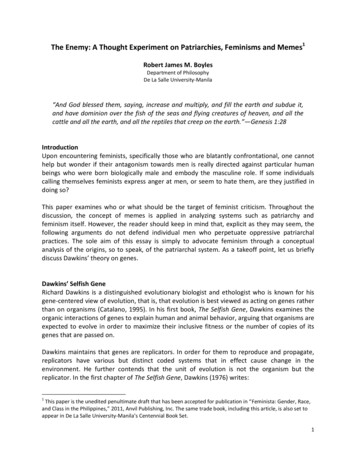
Transcription
The Enemy: A Thought Experiment on Patriarchies, Feminisms and Memes1Robert James M. BoylesDepartment of PhilosophyDe La Salle University-Manila“And God blessed them, saying, increase and multiply, and fill the earth and subdue it,and have dominion over the fish of the seas and flying creatures of heaven, and all thecattle and all the earth, and all the reptiles that creep on the earth.”—Genesis 1:28IntroductionUpon encountering feminists, specifically those who are blatantly confrontational, one cannothelp but wonder if their antagonism towards men is really directed against particular humanbeings who were born biologically male and embody the masculine role. If some individualscalling themselves feminists express anger at men, or seem to hate them, are they justified indoing so?This paper examines who or what should be the target of feminist criticism. Throughout thediscussion, the concept of memes is applied in analyzing systems such as patriarchy andfeminism itself. However, the reader should keep in mind that, explicit as they may seem, thefollowing arguments do not defend individual men who perpetuate oppressive patriarchalpractices. The sole aim of this essay is simply to advocate feminism through a conceptualanalysis of the origins, so to speak, of the patriarchal system. As a takeoff point, let us brieflydiscuss Dawkins’ theory on genes.Dawkins’ Selfish GeneRichard Dawkins is a distinguished evolutionary biologist and ethologist who is known for hisgene-centered view of evolution, that is, that evolution is best viewed as acting on genes ratherthan on organisms (Catalano, 1995). In his first book, The Selfish Gene, Dawkins examines theorganic interactions of genes to explain human and animal behavior, arguing that organisms areexpected to evolve in order to maximize their inclusive fitness or the number of copies of itsgenes that are passed on.Dawkins maintains that genes are replicators. In order for them to reproduce and propagate,replicators have various but distinct coded systems that in effect cause change in theenvironment. He further contends that the unit of evolution is not the organism but thereplicator. In the first chapter of The Selfish Gene, Dawkins (1976) writes:1This paper is the unedited penultimate draft that has been accepted for publication in “Feminista: Gender, Race,and Class in the Philippines,” 2011, Anvil Publishing, Inc. The same trade book, including this article, is also set toappear in De La Salle University-Manila’s Centennial Book Set.1
The argument of this book is that we, and all other animals, are machines created by ourgenes I shall argue that the fundamental unit of selection, and therefore of selfinterest, is not the species, nor the group, nor even, strictly, the individual. It is the gene,the unit of heredity.Genes, according to Dawkins, cause the existence of life in the world. In effect, organisms arerelegated to a means for the survival of genes; organisms only act as hosts. Dawkins states thatgenesare in you and me; they created us, body and mind; and their preservation is theultimate rationale for our existence. They have come a long way, those replicators. Nowthey go by the name of genes, and we are their survival machines.Further, Dawkins argues that:The evolutionary importance of the fact that genes control embryonic development isthis: it means that genes are at least partly responsible for their own survival in thefuture, because their survival depends on the efficiency of the bodies in which they liveand which they helped to build.Before Dawkins introduced this idea, the common belief was that the benefits to the organismaccounted for genes responsible for the tendency towards that behavior. Catalano (1995)points out that what Dawkins is able to do is to maneuver a shift from the organism as theprimary unit of evolution to the characteristics of the gene; the selection based on genesoverrides the selection on the level of organisms most of the time. However, Dawkins does notstop there. He develops his theory further so that it crosses the border into understandingculture and society.The Selfish MemeA meme is a theoretical unit of cultural information that was first coined by Dawkins in TheSelfish Gene (Silby, 2000, p. 1). Memes are ideas that inhabit minds. They are comparable togenes in a sense that they evolve according to the same principles that govern biologicalevolution.This unit of cultural transmission or imitation, for memeticists, can be considered as thebuilding block of cultural evolution and diffusion through mind-to-mind propagation. Dawkins(1976) writes:Examples of memes are tunes, ideas, catch-phrases, clothes fashions, ways of makingpots or of building arches. Just as genes propagate themselves in the gene pool byleaping from body to body via sperm or eggs, so memes propagate themselves in the2
meme pool by leaping from brain to brain via a process which, in the broad sense, canbe called imitation.Further, he elaborates on the propagation of ideas:If the idea catches on, it can be said to propagate itself, spreading from brain to brain When you plant a fertile meme in my mind you initially parasitize my brain, turning itinto a vehicle for the meme’s propagation in just the way that a virus may parasitize thegenetic mechanism of a host cell.Dawkins parallels memes with genes. For Dawkins, “Memes are to cultural inheritance whatgenes are to biological heredity” (Catalano, 1995). The two are subject to natural selectionwherein human evolution, as Dawkins postulates, is the co-evolution between genes andmemes; through the replication process, memes propagate culturally. Analogous to the ideason natural selection, the memes that are able to replicate themselves successfully against theircompetition have a greater chance of survival.The memepool, on the other hand, consists of all existing memes that are good at replicating.These memes produce more copies of themselves in the minds of people or in other mediums(e.g., books, clothes, etc.). Silby explains: “There is a limited amount of memetic storage spaceon this planet, so only the best memes manage to implant themselves” (2000, p. 1). Those thatare not able to replicate themselves eventually become extinct.Hypothesize for a moment and think of the numerous myths, tales, and chants, to name a few,from our early ancestors, that we no longer have any knowledge of. A plausible explanation fortheir disappearance is that these extinct memes failed to replicate themselves compared to themore successful memes—that is, the myths, tales and chants that we still know today.Another concept in memetics (i.e., the study of memes) is the memeplex. According to Silby,memeplexes are memes that have come to rely on each other for replication. These memesband together to become more successful in evolution, which helps the memeplex replicateitself and have a better chance for survival. A competition occurs between numerousmemeplexes wherein those that fail to replicate become extinct.Armed with this background on memes, memeplexes, and the memepool, let us investigatethrough thought experimentation as to how these concepts can shed light on the issue ofwhether any generalized feminist anger at men is justified.History through MemeplexesIn prehistoric times, the most basic human societies lived by hunting animals and gatheringvegetation (Macionis, 2000, p. 94). In this type of society, the hunters and gatherers had littlecontrol over their environment. These people were also nomadic, moving from one place toanother, typically depending on the migratory animal that they hunted.3
At a very young age, men in hunting and gathering societies were trained to hunt while womenwere taught how to collect edible vegetation. During those times, it was possible that mostindividuals looked at men and women as having the same social importance even though thetwo had different responsibilities (Leacock, 1978). But because of the lack of knowledge onone’s biological makeup (e.g., use of birth control techniques, etc.), women got pregnantfrequently and the responsibilities of childcare were delegated to them, keeping them at home.And because it was thought that men were greater in strength, they were deemed better fit forhunting and warfare. In due course, this division of gender roles became institutionalized andwas taken for granted as natural (Lengermann & Wallace, 1985). But how did the patriarchalsystem develop? It’s useful to consider two popular theories.One theory has to do with the invention of the plow. Previously, male and female contributionsto subsistence were equalized by the unreliability of hunting. Although men brought innourishing meats, supplies weren’t as constant as the fruits, seeds, and herbs gathered bywomen. This setup changed when farming was invented and men took control.2 Another theorypoints to the patrilineal system of property inheritance as the main culprit behind sexual doublestandards. Female virginity was prized while female promiscuity was denounced. Thisoppressive “Madonna-Whore” binary is supposed to have ensured the fact that the heirs of theestate were the patriarch’s legitimate children. Thus, as the Marxists argue, the abolition ofprivate property would see the end of not only classism but also sexism.3These two theories illustrate the development of the patriarchal memeplex. It propagated itselfand edged out other memeplexes like matriarchy and ancient Goddess cultures. Through thetest of time, this patriarchal memeplex adapted to the call of natural selection. It was able tostand against the tough challenges of other competing memeplexes including the weakerversions of patriarchy. The intricate collection of memes replicated itself in the minds of people,and for centuries it constantly evolved to adapt to its environment.Through different eras, the patriarchal memeplex replicated itself in the language used bypeople, laws enacted by governments, narratives produced by writers, and so on. One can evensuppose that there were a number of competing memes and memeplexes that posed a stiffchallenge against the patriarchal memeplex, which still permeate in our society today, but all ofthem have so far failed to override it. The idea is not that hard to imagine if one looks at it froma Darwinian perspective. On the presupposition that the view of a Darwinian culture is correct,a possible explanation for the said memeplexes’ resilience can be drawn.In The Origin of Species, Darwin maintains that species are adapted for interaction with itsnatural enemies such as parasites, competitors, and resource supplies (Ridley, 2005, p. 21). It is2See The Underside of History (1992) by Elise Boulding and The Death of Nature: Women, Ecology, and theScientific Revolution (1990) by Carolyn Merchant.3See The Origin of the Family, Private Property, and the State (1884) by Friedrich Engels.4
therefore possible to apply this notion to the patriarchal memeplex. Using Catalano’s (1995)analogy that “Memes are to cultural inheritance what genes are to biological heredity,” amemeplex can therefore adapt to their environment and learn how to interact with theircompetitors. The patriarchal memeplex having replicated successfully, one can argue that, untilrecent history, it was favored by the law of natural selection.It can be supposed that among competing memeplexes of sexual relations, patriarchy remainedthe most resilient. But now, let us focus on other memeplexes that have challenged thepatriarchal memeplex in unprecedented ways.Freedom from SlaveryThe 1830s saw the rise in America of abolitionism, or the radical anti-slavery movement whichdemanded the immediate cessation of slavery on the grounds that everyone is a self-owner.The movement centered on the idea that “every human being has a moral jurisdiction over hisor her own body” (McElroy, 2006).Although certainly less influential, the abolitionist memeplex competed with the patriarchalmemeplex. The competition between memeplexes is illustrated by Darwin’s principle ofdivergence, which:concerns the relative strength of competition In general we can consider the relativestrength of competition that any individual experiences from other individuals like itselfand from other, different forms. The competition from the other life forms like itself willgenerally be much stronger: they will be exploiting similar resources. (Ridley, 2005)Further, Ridley states that:In a crowded environment, the way to avoid competition is to evolve to becomedifferent from other, similar life forms to yourself.This gives us a probable explanation of how abolitionism could have started. Remember that, asfar as this paper is concerned, systems (e.g., patriarchy, abolitionism, etc.) are memeplexes.And as mentioned earlier, there is only a limited amount of memetic storage space in theworld. Relating this idea to Darwin’s principle of divergence, one can argue that because thepatriarchy and abolitionism fight for the same resource, the minds of people, one of themevolved into a completely different form.Because the patriarchal memeplex is more adaptive, the abolitionist memeplex had to evolveinto something different in order for it to survive. That is to say, the abolitionist memeplexcould have gone extinct if it had not branched out into a different form.Citing the principle of divergence again, Ridley states:5
Darwin suggested that competition between varieties within a species would causethem to diverge further apart, until they became different species. Then competitionbetween the two species would drive them apart until they become two genera. Theprinciple of divergence drives all evolutionary lineages apart and results in the tree-likepattern of evolution on the grand scale. (2005, p. 25)Although it did not replace patriarchy, abolitionism possibly led to an important historicaldivergence from the logic of oppression. This is where the feminist memeplex comes in.Freedom and Sexual EqualityAnother memeplex that could have possibly evolved through the principle of divergence is thefeminist memeplex. McElroy states that during the height of the abolitionist movement,women played a huge role in such organized, radical fight against oppression, which marks thetime when “a woman’s movement sprang.” To a certain extent, feminism has its roots in theabolitionist movement.4 Further, McElroy (2006) cites historian Aileen Kraditor:A few women in the abolitionist movement in the 1830s found their religiouslyinspired work for the slave impeded by prejudices against public activity by women.They and many others began to ponder the parallels between women’s status and theNegro’s status, and to notice that white men usually applied the principles of naturalrights and the ideology of individualism only to themselves.This exemplifies how Darwin’s principle of divergence could explain the birth of feminism. Asmentioned earlier, it all started with abolitionism. During that time, women began to realizethat they were also subject to oppression like the slaves, initially fighting with them. But anumber of women began to plant the seeds of feminism. At first, they created a new meme inthe context of abolitionism. But as it grew, by replicating in the minds of feminist women andmen, this meme evolved into a memeplex of its own.Thus, as the more focused feminist memeplex competed with the more generalized abolitionistmemeplex, the former had to evolve into a different form. Since the two shared a similarresource—that is, the energies and allegiances of groups of people, feminism had to divergefrom abolitionism in order to survive. From the meme advocating freedom from slavery, a newmeme that advocated equality between men and women evolved alongside other relatedmemes, forming a new memeplex.4The anti-slavery movement took place in the United States, so the development of feminism as discussed in thispaper refers to the American context. Nonetheless, the argument linking the oppression of certain groups (e.g.,slaves, the poor, colonized races, etc.) and that of women as a sex class, still stands. The development offeminisms globally has frequently coincided with the rise of emancipatory movements such as liberalism,Marxism, socialism, and nationalism. See in particular the history and philosophy of feminisms in the Philippinesas discussed by Arnado and dela Cruz, respectively, in this volume.—Eds.6
But as it is commonly known, feminism has a number of types that fall under it, which is why itis more apt to use the term feminisms. Each type has its own distinct characteristics, at timesconflicting with others. But the memeplex of feminism, or feminisms, acts like an umbrella thatencompasses all of these. What seems to be common to all of them is the belief that womenare oppressed by men in the context of patriarchy. Stewart (2000) writes,Feminism is the organized movement which promotes equality for men and women inpolitical, economic and social spheres. Feminists believe that women are oppressedsimply due to their sex based on the dominant ideology of patriarchy.The idea of a single memeplex for the entire feminist movement is quite feasible. With thatsaid, let us try to explain what the possible reason could be for women to be oppressed in thepatriarchal system. Is it the result of the conscious, willful effort of individual men to oppressindividual women? Or could it be something else? Lets us discuss a few other concepts that Ithink will help us identify the real “enemy.”The Gene of SelfishnessGenes, as defined by Dawkins, are selfish, as they increase their own chances of survival in thegene pool at the expense of their alleles. The gene is thus the basic unit of selfishness. To acertain extent, Dawkins seems to think that the individual can still exercise control; but becausethis is not apparent to us, it would be very difficult to do so. He writes,Not only are brains in charge of the day-to-day running of survival machine affairs, theyhave also acquired the ability to predict the future and act accordingly. They even havethe power to rebel against the dictates of their genes, for instance in refusing to have asmany children as they are able to. But in this respect man is a very special case, as weshall see. (Dawkins, 1989).He further states that:The genes are the master programmers, and they are programming for their lives. Theyare judged according to the success of their programs in coping with all the hazards thatlife throws at their survival machines, and the judge is the ruthless judge of the court ofsurvival. . . . Whenever a system of communication evolves, there is always the dangerthat some will exploit the system for their own ends.Relating this to his ideas in Viruses of the Mind, one could draw the inference that the hostrarely realizes that he or she has already been infected by an unknown virus.Like computer viruses, successful mind viruses will tend to be hard for their victims todetect. If you are the victim of one, the chances are that you won't know it, and mayeven vigorously deny it. Accepting that a virus might be difficult to detect in your ownmind, what tell-tale signs might you look out for? (Dawkins, 1993)7
It is possible that the hosts may not be aware that they are already inflicted with a virus, or, inthe contest of this discussion, a memeplex. One might contend that it is still up to the individualto be responsible for knowing that he or she is already infected, but this is not always the case.In another article, What Use is Religion?, Dawkins explains the idea that there is something inus, in our biological structure, which is susceptible to these kinds of viruses.Natural selection builds child brains with a tendency to believe whatever their parentsand tribal elders tell them. And this very quality automatically makes them vulnerable toinfection by mind viruses. For excellent survival reasons, child brains need to trustparents and trust elders whom their parents tell them to trust. An automaticconsequence is that the “truster” has no way of distinguishing good advice from bad.The child cannot tell that “If you swim in the river you’ll be eaten by crocodiles” is goodadvice but “If you don’t sacrifice a goat at the time of the full moon, the crops will fail” isbad advice. They both sound the same. Both are advice from a trusted source, and bothare delivered with a solemn earnestness that commands respect and demandsobedience. (Dawkins, 2007)Having presented the arguments above, let us now assess if there are any grounds for holdingmen responsible if they continuously adhere to the patriarchal memeplex. Are individual menthe enemy?The EnememeAs mentioned above, the patriarchal memeplex is deeply ingrained in us. Through the passageof time, it has adapted and evolved to meet the demands and challenges of other competingmemeplexes in the memepool. Because it is deeply embedded in us, in our biological structureto a certain extent, it is very difficult for anyone to detect if he or she is already infected by it(Macionis, 2000, p. 123).Looking at how history transpired, or at least how it could have from the start, the memeplex ofpatriarchy eagerly and selfishly replicated itself. This means that different sets of memes joinedto push the agenda of the patriarchal memeplex. These memes are not limited to language orsocial customs alone. As Dawkins (1976) argues, memes could be “tunes, ideas, catch-phrases,clothes fashions, ways of making pots or of building arches.” In order for the memeplex ofpatriarchy to successfully propagate, there are a number of memes that help to spread thememeplex in the minds of individuals, thus parasitizing them.Because we were born into a particular social reality that is patriarchal, we heavily dependedon the guidance of our parents and the environment around us during our childhood. Becausemost, if not all, individuals around us were shaped, or infected, by the memeplex of patriarchy,these people have grown and learned to adapt to this dominant system. In the absence ofeducation, an ideological shift, or the experience of shared oppression resulting in empathy, itis difficult for individuals to realize that they are indeed infected by this virus. If one is so used8
to doing things the way he or she has always done, detecting the virus would be extremelyeasier said than done. Arguably, the only time the virus manifests itself is when oppression hasalready been experienced.Hence, individual men are not the actual enemy of feminists. The real enemy is the system, thepatriarchal memeplex. It tolerates, breeds, and encourages the oppression of women. Itperpetuates oppressive thoughts about women because of its constant desire to selfishlyreplicate itself. Men and women are just sacrificial pawns of the system’s craving to propagateitself.Before concluding the discussion, let us consider Karl Marx’s relevant insights.Remembering MarxMarx, in his discussion of social conflict during his time, presents the idea of classconsciousness. This is “the recognition by workers [the proletariats] of their unity as a class inopposition to capitalists and ultimately, to capitalism itself” (Macionis, 2000, p. 105). Theproletariat provides labor to operate the productive enterprises of capitalists. Once theyrecognize that the system of capitalism creates class conflict, the workers would push for theeventual overthrow of the system—not of individual capitalists. Targeting the capitalists is whatMarx describes as false consciousness. In discussing Marx’s notion of false consciousness,Macionis writes:False consciousness. . . [is the product of] explanations of social problems in terms ofthe shortcomings of individuals rather than the flaws of society. Instead, he [Marx]thought industrial capitalism itself was responsible for the social problem he saw allaround him. False consciousness, he maintained, victimizes people by hiding the realcause of their problems. (2000, p. 103)What Marx gives us is the idea that everyone is oppressed by the capitalist system, and thereason for class conflict is not the capitalist themselves, but this system. If this is not yet alreadyblatantly right in front of us, there is some sense in saying that the capitalists, the bourgeoisie,despite their economic advantages, are victims as well. The adverse effects of the system thatcreates their privileged class include the dearth of individual responsibility and empathy, to saynothing of their participation in the pernicious logic of dominance.Relating this to the patriarchal system, one could argue that men are not the real enemy; theytoo are victims. Condemning individual men as the source or cause of conflict and oppression isa form of false consciousness. As Kaufman (2000) cogently argues, men no less than women areadversely affected by patriarchy, inasmuch as their experience of power is inextricable withpain. Thus, as feminism promises to equalize male and female access to power, so too does itlessen men’s pain.Patriarchies and feminisms are in fact, systems. They are so intricate, so deeply ingrained in us,that individuals barely notice how pervasively they are practiced and lived. If men oppress9
women, this may be due in part to the infection of an unseen parasite, a mind virus. In order toemancipate its victims, to prevent further cruelty, everyone—male and female—has tooverthrow the cause of conflict: the system.10
ReferencesCatalano, J. 1995. Richard Dawkins: Books. [Review of the book The Selfish Gene (1989) byRichard Dawkins.] Oxford University Press Review. Retrieved 26 October 2007 kins-rchive/Dawkins/Work/Books. 1995. Revolutionary Evolutionist. Wired Magazine. Retrieved 26 October 2007 kinsDawkins, C.R. 1976. The Selfish Gene. Retrieved 7 November 2007 memes.html. 1993. Viruses of the Mind. Retrieved 11 March 2007 fromhttp://cscs.umich.edu/ crshalizi/Dawkins/viruses-of-the-mind.html. 1996. The Blind Watchmaker. New York: W.W. Norton & Company. 2007. What Use is Religion? Free Inquiry Magazine. Retrieved 11 March 2007from http://www.secularhumanism.orgKaufman, M. 2000. Men, Feminism, and Men’s Contradictory Experiences of Power. In AnneMinas (Ed.), Gender Basics: Feminist Perspectives on Men and Women. California:Wadsworth Publishing.Leacock, E. 1978. Women’s Status in Egalitarian Societies: Implications for Social Evolution.Quoted in Macionis, J.J. 2000. Sociology 3rd ed., 95. Singapore: Pearson Education Asia PteLtd.Lengermann and Wallace. 1985. Gender in America: Social Control and Social Change. Quotedin Macionis, J.J. 2000. Sociology 3rd ed., 337. Singapore: Pearson Education Asia Pte Ltd.McElroy, W. 2006. The Roots of Individual Feminism in 19 th Century America. Freedom,Feminism, and the State Internet. Retrieved 7 November 2007 fromhttp://www.ifeminists.netMcGrath, A. 2005. Dawkins’ God: Genes, Memes, and the Meaning of Life. United Kingdom:Blackwell Publishing.Ridley, M. 2005. How to Read Darwin. Great Britain: Granta Publications.Silby, R. 2000. What is a Meme? Retrieved 7 November 2007 fromhttp://www.defogic.com/articles/what is a meme.htmlStewart, C. 2003. Different Types of Feminist Theories. Retrieved 11 March 2007 ory84.htm11
discuss Dawkins’ theory on genes. Dawkins’ Selfish Gene Richard Dawkins is a distinguished evolutionary biologist and ethologist who is known for his gene-centered view of evolution, that is, that evolution is best viewed as acting on genes rather than on organisms (Catalano, 1995). In his first book










